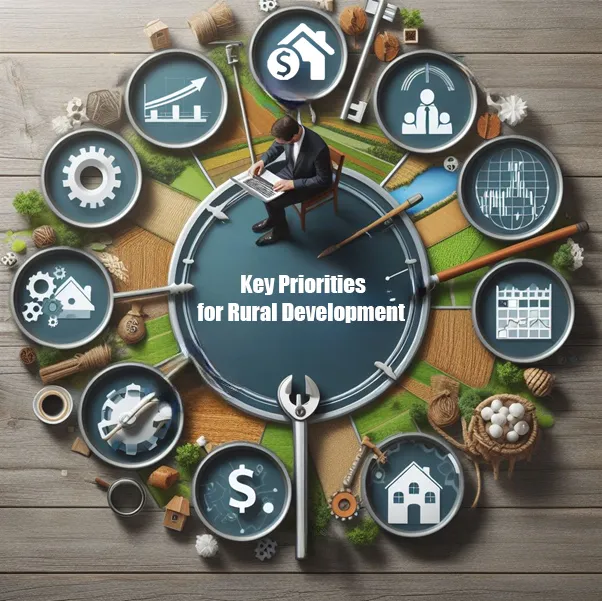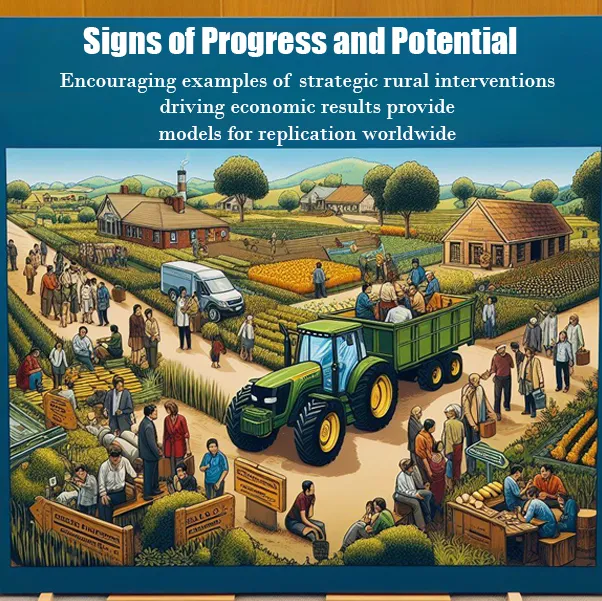Introduction
Rural regions are home to almost half the world’s population today, including a vast majority of the extremely poor. Uplifting the prosperity of countryside areas through better infrastructure, services, and economic opportunities represents a moral imperative. Strategic investments enabling Rural Economic Development also promise massive macroeconomic growth potential for developing countries aiming to reach higher income status.
The Economic Promise of Rural Areas
Too often rural communities are viewed as backward backwaters holding back national advancement. However, economically vibrant rural areas provide the essential foundations needed to reduce poverty, improve equality, and drive widespread inclusive growth.
Key reasons strategic Rural Economic Development unlocks major overall growth include:
- Food Security – Thriving agricultural communities increase domestic food production reducing import reliance and boosting farmer incomes to afford nutritious diets. This prevents malnutrition from hindering development.
- Supply Chain Efficiency – Shortening supply chains via local rural manufacturing or processing boosts competitiveness. Reduced waste and logistics costs enhance access to global markets.
- Urban Savings – Slowing excessive congestion growth in megacities limits costly urban housing shortages and infrastructure constraints. More balanced regional development eases fiscal stress.
- Innovation Spillovers – Solutions proved first improving lives or livelihoods rurally like off-grid solar and mobile platforms enable replication across geographies. Knowledge flows multiply exponentially.
Overall, strategic efforts enabling Rural Economic Development provide the essential base layer for sustainable and equitable national growth trajectories in the 21st century.

The Rural Reality Today
Rural populations face systemic disadvantages in almost every measure of prosperity and well-being. Income levels commonly sit at half of urban peers or often much less. Access to healthcare, financial tools, electricity, and transportation infrastructure consistently lags sometimes by huge margins. Educational options and digital connectivity remain limited as well despite global advancements.
These gaps then self-reinforce in cycles of poverty. Lower incomes mean less tax revenue available to fund service improvement. Missing infrastructure like roads, electricity, and the internet then inhibits the growth of businesses or skills needed to raise incomes over time.
Breaking this cycle requires intentional, patient public investment in Rural Economic Development foundations. Market forces alone will not close rural-urban divides rapidly enough without proactive, thoughtful programs tailored to local contexts.
Key Priorities for Rural Development
Transforming Rural Economic Development requires parallel progress upgrading several enablers in a coordinated fashion. Incremental change on single factors fails to drive systemic shifts. Interlinked efforts spanning infrastructure buildout, skills development, agricultural evolution, and governance modernization provide the most effective rural intervention blend.
Infrastructure as a Launch Pad
Physical infrastructure unlocks access to essential services, market connections and quality of life needs underpinning prosperity. Areas like electrification, roads, digital networks, storage, and irrigation provide fundamental launch pads enabling rural commerce and service delivery. Infrastructure also directly creates construction jobs in the short-term during buildout supporting local multipliers.
Skills and Capability Building

Education policies should equip rural youth with both technical abilities and soft skills to meet the needs of current/future labor markets. A curriculum incorporating digital literacy along with creative problem-solving and communication aptitudes helps link into the modern economy. Apprenticeship programs and vocational training oriented to priority rural sectors like agriculture, manufacturing, or artisanal trades also bolster employability and income mobility.
Agricultural Evolution
Farming sustains direct livelihoods for billions globally even while absorbing workers displaced from other manual professions. Enhancing productivity, resilience, and market linkages in the agricultural sector spurs significant direct and indirect job creation helping rural regions. The adoption of appropriate technologies (sensors, cold storage, safety techniques, etc.) combined with improved information, financial access, and sustainability practices compounds rural prosperity.
Modernized Governance
Bureaucratic hurdles often impose the highest hidden tax on grassroots economic potential. Simplifying licensing, registration, and compliance processes saves money for bootstrapping entrepreneurs while enabling access to programs supporting growth like trade credit or technology subsidies. E-governance solutions along with decentralized decision authority also help tailor policies to local rural contexts better while enhancing inclusion.
Pursuing progress across each of these pillars in a synchronized fashion sets the stage for widespread rural region prosperity over a 5-10-year timeframe.
Signs of Progress and Potential
Encouraging examples of strategic rural interventions driving economic results provide models for replication worldwide:
Rural Electrification (Bangladesh)

Bangladesh has utilized microgrids, solar home systems, and renewable energy incentivization to lift national electricity access from 20% to over 90% of households in just over a decade. This Rural Economic Development enabler spurs productivity for farms, factories, and small businesses while improving quality of life. Women are especially empowered by reliable lighting improving safety and possibilities for night education.
Digital Agriculture (India)
India’s national digital architecture linking biometric IDs with mobile payment systems and data analytics now facilitates financial inclusion, market linkages, and technology extension services across the agriculture sector. Platforms like Ninjacart and DeHaat provide services ranging from e-commerce aggregation to personalized agronomic coaching expanding outcomes beyond subsistence farming.
Transportation Infrastructure (Peru)
Peru has pioneered participative budgeting models engaging local communities alongside engineers to optimize rural roads, waterways, and trail upgrades matching local usage patterns. This inclusive planning approach increased infrastructure reliability supporting wider prosperity for decades while also skilling up maintenance workforces through on-the-job training during construction.
Vocational Training (Singapore)

Singapore’s SkillsFuture program provides every citizen over 25 with a specially funded skills development account. Rural cohorts utilize the budgets pursuing certifications related to fabrication, equipment repairs, craftsmanship, and agricultural technologies improving both earnings trajectories and youth engagement.
These initiatives showcase the economic unlock once holistic rural advancement reaches critical mass. Multiple other countries now pursue similar village clusters and livelihood zone concepts coordinating public, private, and philanthropic efforts on aligned objectives, pooled resources, and clear outcome tracking.
Conclusion
Rural regions undeniably represent the greatest remaining frontier for equitable economic development globally. No country has achieved high and rising living standards with cities alone. Embracing rural prosperity pillar by pillar can power national growth for decades while meaningfully improving billions of lives along the way.
Patient, pragmatic policy-making and financing models can make rural infrastructure, skills, and innovation ecosystem visions into widespread reality. Global connectivity and data insights will only accelerate knowledge transfer enabling local solutions adaption as well.
With collaboration, empathy, and smart economics, Rural Economic Development can certainly thrive across Africa, Asia, and the Americas just as abundantly as urban clusters already have in many geographies. The world increasingly recognizes uplifting rural areas is not charity but rather self-interest – a precondition to broader stability and a multiplier of shared prosperity regardless of where one lives.



